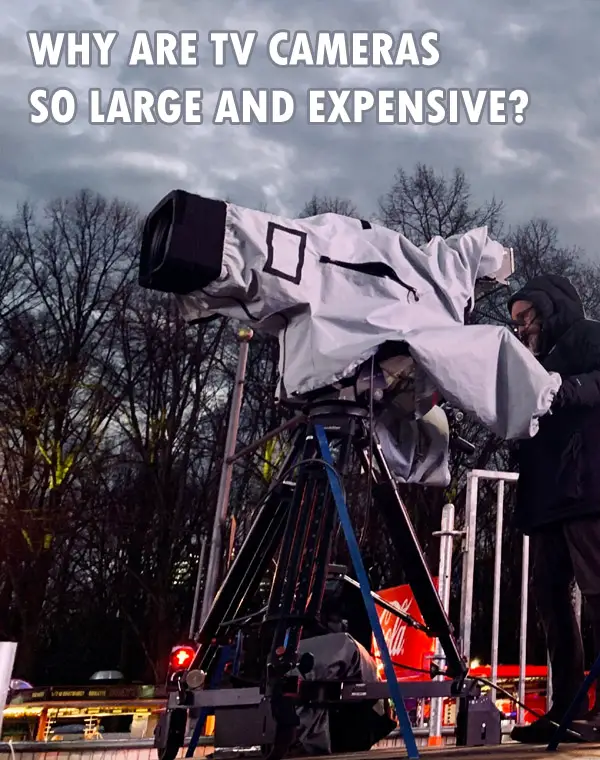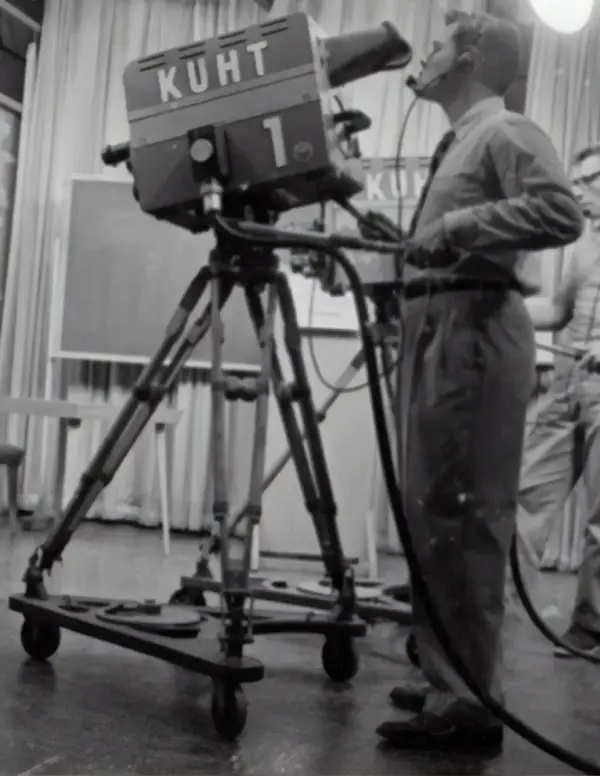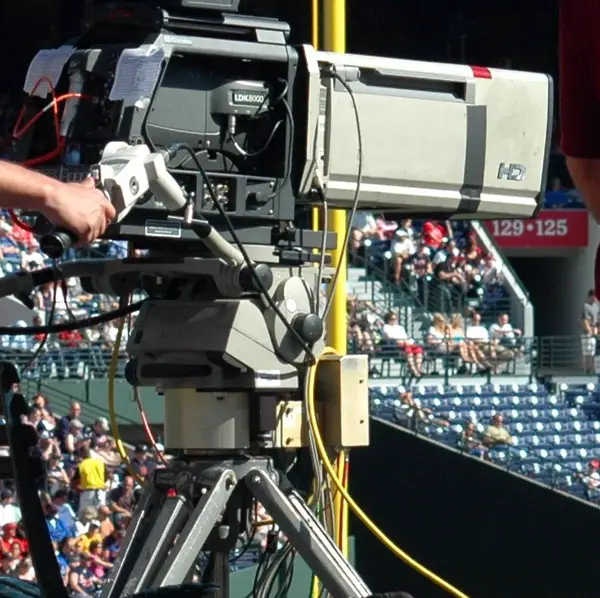Ever wondered what makes a professional broadcast camera so expensive and huge when other cameras can now easily fit in your pocket or phone and cost less and less?

In this article I will discuss the reasons for this discrepancy, some of which will surprise you.
There are several reasons why TV cameras are so expensive, some of which have to do with the size. And this has not changed in decades. Let’s discuss.

The Cost and Size of TV Camera Lenses
Well, one major contributor is the lens.
A top-notch broadcasting lens can cost as much as $200,000. You see, these lenses are designed to capture objects kilometers away with high precision. This requires long focal lengths which aren’t cheap.
Understanding Focal Lengths in Broadcast Lenses
Besides being pricey, these lenses need valuable zoom capabilities coupled with a large focal range. This means having par-focal capability – maintaining focus when changing zoom levels without any loss in clarity or detail, which is not cheap.
Components that Contribute to Lens Size
A broadcast camera lens with a 900mm focal length and an f4.5 max aperture necessitates an optical diameter of 200mm, thus requiring a larger box housing to fit all components needed for operation, including electronics that control zooming or focusing. This means a larger box housing is needed to accommodate all the necessary components:
- An array of electronic parts controls various functions like zooming or focusing.
- Motorized servos provide smooth transitions between different scenes.
- Premium quality glass elements ensure sharp image capture even from long distances, among other factors contributing to their hefty sizes and prices.
The Role of Electronic Parts Within Broadcast Camera Lenses
In addition to the mechanical aspects, numerous electronics are involved in each unit. These include processors that control motor movements based on input signals received via remote controls, sensors that monitor light levels and adjust accordingly, maintaining optimal exposure throughout usage. All these factors combined result in the large-sized bulky devices commonly used across media houses globally today.
Role of Image Stabilization
In addition to all this complexity, there’s also image stabilization at play. Image stabilization ensures clear shots even under unstable conditions.
In our next section, we’ll dive into another component contributing significantly not only to the size but also weight: The Tripod used for Broadcasting Cameras.
The Design and Functionality of Tripods in Broadcasting
Let’s dive into the world of broadcasting tripods. A tv tripod may cost $15,000-$20,000.

These aren’t your average photography stands. They’re the superheroes of stability. And these bad boys can handle any weather – rain or wind, they’ve got it covered. They include a fluid head that is like the fine fluid head on a prosumer camcorder, but on steroids.
Adjusting Dampening Levels on Broadcast Tripods
Dampening levels are a critical feature to understand when it comes to professional-grade tripods used in broadcast settings.
Some tripods offer adjustable resistance for smooth panning and tilting movements during filming.
This precise control over movement is vital, especially while capturing fast-paced action or making subtle changes without disrupting the shot.
Breaking Level Controls on Professional Tripods
In addition to dampening adjustments, breaking level controls play an equally important role.
They provide stability by locking the tripod head position firmly once the desired framing is achieved. This helps maintain consistency throughout recording sessions, avoiding accidental shifts that could potentially ruin shots.
Professional-grade tripods have a robust build quality with heavy-duty materials designed to withstand rigorous use in harsh environments, ensuring longevity and reliability under demanding shooting conditions.
Bulkiness vs Stability: The Trade-Off In Broadcast Camera Setup
No doubt these features make the setup more cumbersome, but they are a necessary evil due to their advantages being greater than any potential drawbacks. Particularly in live broadcasts where there are no second chances at capturing moments with perfect precision, utmost importance is placed on stability.
Understanding the design and functionality of broadcasting equipment like tripods can help you better appreciate the complexities behind producing high-quality video content.
Monitors & Remote Controls: Essential Tools for Broadcasting Cameras
A professional broadcast camera setup is incomplete without a high-quality monitor, which can easily cost $2000.
This integral part of the system not only adds to its overall size but also plays an essential role in delivering live telecasts with precision and clarity.
Monitor Displays: Precision and Convenience
Monitor displays on broadcast cameras are meticulously designed for accuracy and user-friendliness. Besides offering enhanced control over visual output, this function helps maintain accuracy throughout lengthy filming sessions by reducing strain on operators’ eyes and necks due to constant adjustments required for ideal framing.
Their generous size allows for easy tilting, while offering quick access controls like focus peaking, contrast, and saturation. No need to fiddle with lens settings and risk disrupting ongoing recording sessions.
Remote Control Operation
Broadcasting camera setups often include remote control operation systems. This nifty feature allows operators to adjust various parameters from a distance, minimizing disruptions during filming sessions. You have to avoid touching the lens while adjusting focus or other settings during live telecasts. Highly precise motors come into play here. They operate the camera remotely, ensuring smooth transitions between scenes without abrupt changes that could disrupt the viewer experience.
Advantages of Remote-Operated Motors in Live Telecasting
You might be thinking: “What makes these remote-operated motors stand out?”
- Precision: These motors offer unmatched precision, making subtle alterations on-the-fly for perfect shots.
- Flexibility: With remote controls, operators have the freedom to move around, especially useful for covering large events or moving subjects.
- Safety: Avoiding direct contact with expensive equipment reduces the risk of accidental damage, a significant concern when dealing with high-end broadcast gear.
Now, let’s dive into another crucial aspect of professional photography: the intricate process of building a broadcasting camera body. This will give us insight into the features that make these cameras distinct from those made for general consumers.
The Complexity Behind a Broadcasting Camera Body
When it comes to professional broadcast cameras, the body is more than just a shell.
It’s an intricate piece of technology that houses several advanced features not found in consumer-grade devices. Cameras may cost $5000 or more.
Unique Features Present in Professional Grade Cameras
Sophisticated Imaging Sensors:
Broadcasting camera bodies are equipped with advanced imaging sensors.
This allows them to capture high-quality images under various lighting conditions and deliver superior image resolution compared to standard digital cameras.
Lightning-Fast Circuitry:
The circuitry design within these camera bodies is another unique feature.
Complex circuits help process data at lightning speed, ensuring seamless recording even when capturing fast-paced action.
Efficient Heat Dissipation:
Professional-grade broadcasting cameras come with better heat dissipation mechanisms.
This prevents overheating during prolonged use and contributes significantly towards maintaining optimal performance levels.
Despite their compact size relative to other components like lenses or tripods, the role of the camera body should never be underestimated.
Each element housed within this small space plays a crucial part in delivering exceptional results under demanding shooting conditions.
While implementing all these sophisticated elements does take up some space inside the device, they’re absolutely necessary for excellent performance.
Conclusion
Broadcast TV cameras are large and expensive for a reason. It is due to the environment and requirements of live tv, where equipment and operator errors are not forgivable. From the giant lenses to heavy duty perfectly smooth tripods, they are a great piece of engineering. Looking at the prices mentioned, a full broadcast camera setup can run $250,000 or more. Click the following link to learn whether camera tripods are universal.








